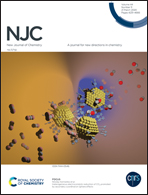Formulation and evaluation of β-cyclodextrin-mediated inclusion complexes of isoniazid scaffolds: molecular docking and in vitro assessment of antitubercular properties†
Abstract
Poor aqueous solubility is the major problem encountered with formulation of new bioactive chemical entities. In the present study, we report the synthesis and evaluation of inclusion complexes between two poorly water soluble antitubercular agents (p-hydroxybenzaldehydeisonicotinylhydrazone (HBIH) and 2,3-butanedionebisisonicotinylhydrazone (BDIH)) and β-cyclodextrin. The solubility of these compounds has been enhanced by inclusion complexation and the solid complexes were characterized using FTIR, PXRD, NMR and SEM. Phase-solubility studies indicated that HBIH/BDIH formed a 1 : 1 stoichiometric inclusion complex with β-CD. Moreover, molecular docking analysis identified the most favorable host–guest interactions in the inclusion complexes. The complexes were evaluated against Mycobacterium tuberculosis strains and exhibited more than 95% growth inhibition. The complexes were devoid of cytotoxicity when tested against the L929 fibroblast cell line. Docking studies were carried out on DprE1 and thymidine monophosphate kinase protein enzymes to provide some understanding of the mechanism of action of these compounds.



 Please wait while we load your content...
Please wait while we load your content...